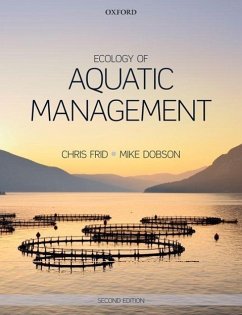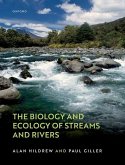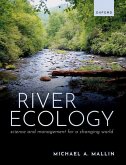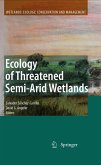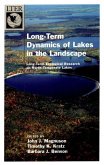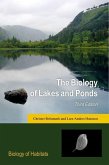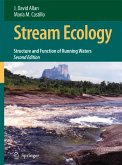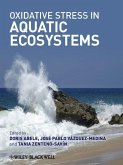- Broschiertes Buch
- Merkliste
- Auf die Merkliste
- Bewerten Bewerten
- Teilen
- Produkt teilen
- Produkterinnerung
- Produkterinnerung
Ecology of Aquatic Management explores current exploitation practices, the ecological basis and consequences of that exploitation, and means of sustainable management of marine and freshwater systems.
Andere Kunden interessierten sich auch für
![The Biology and Ecology of Streams and Rivers The Biology and Ecology of Streams and Rivers]() Alan HildrewThe Biology and Ecology of Streams and Rivers150,99 €
Alan HildrewThe Biology and Ecology of Streams and Rivers150,99 €![River Ecology River Ecology]() Michael A MallinRiver Ecology150,99 €
Michael A MallinRiver Ecology150,99 €![Ecology of Threatened Semi-Arid Wetlands Ecology of Threatened Semi-Arid Wetlands]() Ecology of Threatened Semi-Arid Wetlands112,99 €
Ecology of Threatened Semi-Arid Wetlands112,99 €![Long-Term Dynamics of Lakes in the Landscape Long-Term Dynamics of Lakes in the Landscape]() John J MagnusonLong-Term Dynamics of Lakes in the Landscape74,99 €
John J MagnusonLong-Term Dynamics of Lakes in the Landscape74,99 €![The Biology of Lakes and Ponds The Biology of Lakes and Ponds]() Christer BrönmarkThe Biology of Lakes and Ponds154,99 €
Christer BrönmarkThe Biology of Lakes and Ponds154,99 €![Stream Ecology Stream Ecology]() J. David AllanStream Ecology75,99 €
J. David AllanStream Ecology75,99 €![Oxidative Stress in Aquatic Ecosystems Oxidative Stress in Aquatic Ecosystems]() Oxidative Stress in Aquatic Ecosystems208,99 €
Oxidative Stress in Aquatic Ecosystems208,99 €-
-
-
Ecology of Aquatic Management explores current exploitation practices, the ecological basis and consequences of that exploitation, and means of sustainable management of marine and freshwater systems.
Hinweis: Dieser Artikel kann nur an eine deutsche Lieferadresse ausgeliefert werden.
Hinweis: Dieser Artikel kann nur an eine deutsche Lieferadresse ausgeliefert werden.
Produktdetails
- Produktdetails
- Verlag: Hurst & Co.
- 2nd edition
- Seitenzahl: 352
- Erscheinungstermin: 24. Juli 2013
- Englisch
- Abmessung: 244mm x 187mm x 17mm
- Gewicht: 666g
- ISBN-13: 9780199693290
- ISBN-10: 0199693293
- Artikelnr.: 36842380
- Herstellerkennzeichnung
- Libri GmbH
- Europaallee 1
- 36244 Bad Hersfeld
- gpsr@libri.de
- Verlag: Hurst & Co.
- 2nd edition
- Seitenzahl: 352
- Erscheinungstermin: 24. Juli 2013
- Englisch
- Abmessung: 244mm x 187mm x 17mm
- Gewicht: 666g
- ISBN-13: 9780199693290
- ISBN-10: 0199693293
- Artikelnr.: 36842380
- Herstellerkennzeichnung
- Libri GmbH
- Europaallee 1
- 36244 Bad Hersfeld
- gpsr@libri.de
Chris Frid is professor of marine biology at the University of Liverpool and Head of the School of Environmental Science. He was responsible for development of the University of Liverpool's undergraduate degree in Marine Biology and has been jointly responsible for the development of the MSc in Marine Planning and Management. He teaches on marine ecology and ecosystem management. He has published over 85 refereed research papers, many of which deal with pollution (heavy metals, solid wastes, sewage, endocrine disrupters) or human impacts (ecosystem effects of fishing, recreational visitor pressure). He is a UK representative on the ICES Working Group on the Ecosystem Effects of Fishing, a member of the Defra Marine Fisheries Scientific Advisory Committee and an associate editor of the Journal of Applied Ecology. Mike Dobson is Director of the Freshwater Biological Association (FBA). His research centres on the ecology and management of rivers and wetlands, in both temperate and tropical environments, with particular emphasis on land use impacts such as forestry. He is the author of over 50 refereed research papers and has contributed invited chapters to six books. He is a member of the Rivers Biodiversity Integration Group for England, and represents both the FBA and the Society of Biology on the NERC Skills Review. Prior to his current post, he had fifteen years' experience in teaching ecology and aquatic management at undergraduate and postgraduate level. He is a Fellow of the Linnean Society of London.
1: How do humans impact aquatic systems?
2: The dynamics of aquatic systems
Part One: Water as a resource
3: Human use of water
4: Exploiting the physical properties of the aquatic environment
Part Two: Aquatic biota as resources
5: Biological basis for harvesting living organisms
6: Harvesting for economic gain
7: Aquaculture and Ranching
Part Three: Aquatic environments as resources
8: Waste disposal in the aquatic environment
9: Extracting mineral resources from the aquatic environment
10: Exploiting the general aquatic environment for recreation
Part Four: Aquatic environmental management
11: Responding to natural hazards
12: Ecosystem functioning and the provision of ecological goods and services
13: Restoration and recovery of aquatic systems
14: Aquatic management tools and approaches
2: The dynamics of aquatic systems
Part One: Water as a resource
3: Human use of water
4: Exploiting the physical properties of the aquatic environment
Part Two: Aquatic biota as resources
5: Biological basis for harvesting living organisms
6: Harvesting for economic gain
7: Aquaculture and Ranching
Part Three: Aquatic environments as resources
8: Waste disposal in the aquatic environment
9: Extracting mineral resources from the aquatic environment
10: Exploiting the general aquatic environment for recreation
Part Four: Aquatic environmental management
11: Responding to natural hazards
12: Ecosystem functioning and the provision of ecological goods and services
13: Restoration and recovery of aquatic systems
14: Aquatic management tools and approaches
1: How do humans impact aquatic systems?
2: The dynamics of aquatic systems
Part One: Water as a resource
3: Human use of water
4: Exploiting the physical properties of the aquatic environment
Part Two: Aquatic biota as resources
5: Biological basis for harvesting living organisms
6: Harvesting for economic gain
7: Aquaculture and Ranching
Part Three: Aquatic environments as resources
8: Waste disposal in the aquatic environment
9: Extracting mineral resources from the aquatic environment
10: Exploiting the general aquatic environment for recreation
Part Four: Aquatic environmental management
11: Responding to natural hazards
12: Ecosystem functioning and the provision of ecological goods and services
13: Restoration and recovery of aquatic systems
14: Aquatic management tools and approaches
2: The dynamics of aquatic systems
Part One: Water as a resource
3: Human use of water
4: Exploiting the physical properties of the aquatic environment
Part Two: Aquatic biota as resources
5: Biological basis for harvesting living organisms
6: Harvesting for economic gain
7: Aquaculture and Ranching
Part Three: Aquatic environments as resources
8: Waste disposal in the aquatic environment
9: Extracting mineral resources from the aquatic environment
10: Exploiting the general aquatic environment for recreation
Part Four: Aquatic environmental management
11: Responding to natural hazards
12: Ecosystem functioning and the provision of ecological goods and services
13: Restoration and recovery of aquatic systems
14: Aquatic management tools and approaches

